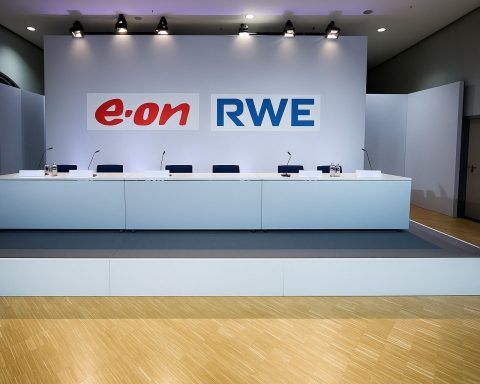Key Facts (October 1 2025 snapshot, updated: 3:00 PM EDT)
- Price: U.S. natural‑gas futures traded at ≈$3.47 per million British thermal units (MMBtu) on 1 October 2025, about 5 % above the previous day’s close and 20 % higher than a year earlier [1].
- Recent Trend: Prices hit a ten‑week high in late September as Lower‑48 production slipped to 107.4 billion cubic feet per day (bcf/d) from 108.3 bcf/d in August and storage injections kept inventories about 6 % above the five‑year average [2].
- Short‑term forecasts: Trading Economics projected natural gas to average $3.70/MMBtu by year‑end and $4.15/MMBtu within twelve months [3].
- Long‑term U.S. outlook: The U.S. Energy Information Administration (EIA) expects the Henry Hub spot price to average $3.00/MMBtu in Q3 2025 and rise through winter to about $4.60/MMBtu in January 2026 due to increased withdrawals for LNG exports and flattening production [4].
- Global demand picture: The International Energy Agency (IEA) reports that global gas demand grew only ~1 % in the first half of 2025, with growth concentrated in Europe and North America; Asian demand was subdued and China’s gas use actually fell 1 % year‑on‑year [5].
- Export surge: U.S. LNG export capacity is expanding rapidly; EIA forecasts exports to increase 36 % from 2024 to 2026 as new terminals like Plaquemines Phase 2, Corpus Christi Stage 3 and Golden Pass come online [6].
- ETF snapshot: The United States Natural Gas Fund (UNG) traded around $13.07 per share on 30 September 2025, having fallen 13.5 % over three months and 20.16 % over twelve months [7].
Current Prices and Recent Trends
Natural‑gas markets entered October 2025 on an upswing. U.S. futures rallied to about $3.47/MMBtu, a level not seen since mid‑July, reflecting supply tightness and shifting expectations [8]. The Lower‑48 output declined to about 107.4 bcf/d, down roughly 1 bcf/d from August, while robust storage injections kept inventories 6 % above the five‑year average [9]. This combination of lower production and relatively full storage suggested that producers were moderating output in response to weak summer prices but may need to increase supply if winter demand spikes.
Demand conditions also contributed to the rally. Weather forecasts in late September called for above‑normal warmth into mid‑October, raising power‑sector gas consumption to meet air‑conditioning load [10]. On the export side, U.S. LNG feedgas flows averaged about 15.7 bcf/d, slightly below August levels but still near record highs [11]. Trading Economics noted that long‑term, new LNG projects could boost global liquefaction capacity by ~60 % by 2030, half of which may come from the United States; this expansion raises the risk of oversupply and lower prices in Asia and Europe but also implies strong domestic gas demand as AI‑driven computing and delays in renewable deployment boost electricity use [12].
The volatility of Henry Hub futures has subsided compared with the extreme swings of 2022–23. The EIA observed that 30‑day historical volatility fell from 81 % in Q4 2024 to 69 % by mid‑2025 as storage inventories returned to more balanced levels [13]. Net injections of more than 100 bcf per week during spring enabled inventories to reach 6 % above the five‑year average, reducing supply concerns and tempering price swings [14]. Nevertheless, the market remains sensitive to weather anomalies—January’s polar vortex briefly lifted volatility to 102 % [15].
Key News Around 1 October 2025
- Lower production and firm demand drive ten‑week highs. A Trading Economics report on September 29 highlighted that U.S. futures hovered near $3.4/MMBtu because output in the Lower 48 slipped, while storage inventories remained robust [16]. At the same time, forecasts of warmer‑than‑usual weather boosted power‑sector demand and offset softer LNG feedgas flows [17]. The article cautioned that, although U.S. output hit a record in August, producers reduced drilling due to low prices, which could tighten supply going into winter [18].
- Price‑sensitive demand in Asia shrinks. The IEA’s Q3 2025 Gas Market Report noted that global gas demand growth slowed markedly; Asia‑Pacific demand is expected to expand less than 1 % in 2025, the weakest growth since 2022 [19]. China’s gas consumption fell 1 % y‑o‑y, and its LNG imports dropped more than 20 %, while India’s demand slid 7 % due to weaker industrial usage [20]. High spot prices—European and Asian hub prices averaged 40 % and 28 % above H1 2024 levels—discouraged buying [21].
- Geopolitical shocks and European supply. In June the Israel‑Iran conflict briefly threatened the Strait of Hormuz, causing TTF and Asian spot LNG prices to spike to around $14–15/MMBtu [22]. Europe’s storages were roughly 79.6 % full by early September 2025, near the EU’s November target, thanks to strong injections and reduced Russian piped supplies [23]. The EU considered new sanctions on Russian banks and energy firms, while Norway’s seasonal maintenance was winding down, improving supply flexibility [24].
- Declining feedgas at major LNG facilities. On August 18 2025 gas demand at Cheniere’s Sabine Pass and Sempra’s Cameron LNG plants fell to 3.7 bcf and 1.3 bcf, respectively, lowering total U.S. LNG feedgas to 14.7 bcf and dragging futures down about 1 % to $2.90/MMBtu [25]. The incident underscored the market’s sensitivity to operational issues at large export terminals.
- Forward‑curve steepness and market expectations. A Reuters analysis from September 2024 (still relevant to forward expectations) noted that Henry Hub futures for 2025 were pricing around $3.20/MMBtu, roughly 44 % higher than the average price in 2024 [26]. U.S. dry gas production averaged 102.5 bcf/d in early 2024 and was expected to rise to 105 bcf/d in 2025, but a 10 % storage surplus limited price progress that summer [27]. The report also indicated that LNG feedgas demand could increase from 13 bcf/d to 17 bcf/d by end‑2025 [28].
Supply and Demand Outlook
United States
The EIA’s Short‑Term Energy Outlook projects U.S. marketed natural‑gas production to average 117.1 bcf/d in 2025 and 116.8 bcf/d in 2026, with growth in the Appalachia and Haynesville basins offsetting slower output in oil‑rich regions [29]. Domestic consumption is expected to average about 91.4 bcf/d by 2026, with the electric‑power sector consuming roughly 40 % of the total [30]. LNG export capacity is the key growth driver; EIA forecasts exports will increase 36 % between 2024 and 2026 as new U.S. terminals—Plaquemines Phase 2, Corpus Christi Stage 3 and Golden Pass—add about 6 bcf/d of capacity [31]. Rising feedgas demand may tighten domestic supply during winter and contribute to higher prices.
Europe
Europe’s gas demand rebounded 6.5 % in the first half of 2025 due to cold weather and weak hydro and wind output [32]. To fill depleted inventories, EU LNG imports reached a record 92 billion cubic metres (bcm) in H1 2025 even as Russian piped supplies fell 45 % and Norwegian flows declined 4.5 % [33]. Storage levels around 79.6 % in early September, combined with sanction‑related uncertainty and geopolitical tensions in the Middle East and Ukraine, have kept European hub prices elevated [34]. As Norway completes maintenance and new LNG cargoes arrive, supply should be comfortable heading into winter, but a severe cold snap or renewed geopolitical disruption could trigger sharp price spikes.
Asia
Asia’s demand growth has decelerated sharply. The IEA reports that China’s gas consumption declined 1 % and India’s dropped 7 % in the first half of 2025 [35]. High spot prices and slower economic growth deterred industrial users, leading to a >20 % reduction in China’s LNG imports [36]. Overall, Asia‑Pacific demand is projected to expand less than 1 % in 2025 [37]. This weakness contrasts with expected demand growth from 2026 onward as new LNG supply from the U.S., Canada and Qatar—expected to increase global supply by 5.5 % in 2025 and 7 % in 2026—reduces prices [38].
Expert Quotes and Opinions
- EIA on price forecasts: The EIA notes that ample inventories kept Henry Hub prices near $3/MMBtu in Q3 2025 but expects prices to rise toward $4.60/MMBtu in January 2026 as LNG exports increase and production growth slows [39].
- IEA on demand slowdown: According to the IEA, global gas demand growth was less than 1 % in H1 2025—the slowest pace since 2020—because Asia’s consumption stalled and prices remained elevated [40] [41].
- IEEFA on sectoral demand: IEEFA data cited by Reuters show that power generation accounts for about 38 % of U.S. gas demand, industry for 32 %, and LNG exports for 10 %; feedgas consumption could rise from 13 bcf/d to 17 bcf/d by late 2025 [42].
- Trading Economics on long‑term risks: Analysts at Trading Economics warn that while new LNG projects will boost global capacity by ~60 % by 2030, half of it from the U.S., the resulting oversupply risk could pressure prices in Asia and Europe unless domestic demand continues to grow due to AI‑driven computing and slower renewable deployment [43].
Price Forecasts and Projections
- Short‑term: Trading Economics expects natural‑gas prices to hover near $3.70/MMBtu by the end of 2025 and rise to $4.15/MMBtu within 12 months [44]. The EIA’s winter outlook is more bullish, projecting a $4.60/MMBtu peak in January 2026 [45]. Both forecasts assume normal weather and continued expansion of LNG exports.
- Medium‑term: The upward‑sloping forward curve observed by Reuters in late 2024 indicated that markets expected 2025 Henry Hub prices around $3.20/MMBtu, about 44 % higher than 2024 levels [46]. However, high inventory levels and potential reductions in industrial demand could cap gains [47].
- Long‑term: Over the coming decade, the proliferation of LNG projects may lead to global oversupply by late 2020s, particularly if Asian demand growth continues to lag; some analysts anticipate modest price increases in the U.S. but caution that volatility will remain elevated due to weather and geopolitics.
Geopolitical, Weather and Economic Factors
- Geopolitics: Conflicts in the Middle East and Ukraine have heightened supply risks. The Israel‑Iran confrontation in June pushed European (TTF) and Asian LNG spot prices above $14/MMBtu [48], illustrating market sensitivity to potential closures of the Strait of Hormuz. Europe’s consideration of new sanctions on Russia and drone incursions into Poland add to uncertainty [49].
- Weather: U.S. prices are highly weather‑dependent. Above‑normal warmth in early autumn boosted demand [50], while a polar vortex in January dramatically increased storage withdrawals and volatility [51]. Winter forecasts will remain a key driver heading into 2026.
- Economic factors: Slower global economic growth, especially in China and India, dampens industrial gas use [52]. In the U.S., AI‑driven electricity demand and delays in renewable generation build‑outs could sustain gas demand growth [53]. Meanwhile, high prices in Europe and Asia encourage energy efficiency and fuel switching.
- Regulation: U.S. pipeline approvals and methane regulations could constrain supply growth, while European carbon policies may accelerate the shift away from gas. The eventual completion of U.S. LNG terminals remains contingent on regulatory approvals and construction timelines [54].
Related Assets and ETFs
Investors seeking exposure to natural gas often use commodity ETFs. The United States Natural Gas Fund (UNG) tracks front‑month futures. As of 30 September 2025 the fund traded around $13.07, having lost 13.5 % over three months and 20.16 % over the past year [55]. These declines reflect the backwardation in the futures curve and the costs of rolling contracts. A more speculative option is the ProShares Ultra Bloomberg Natural Gas (BOIL), a leveraged fund that amplifies daily price moves. Leveraged ETFs can produce large gains during rallies but also magnify losses and decay during periods of sideways trading; thus they are generally suitable only for short‑term traders.
Impacts on Major Energy Companies
- LNG exporters: U.S. exports have become a linchpin of the market. On August 18 2025, gas demand at Cheniere’s Sabine Pass and Sempra’s Cameron LNG fell significantly, driving prices down [56]. These facilities, along with upcoming projects from Venture Global (Plaquemines) and Golden Pass (a joint venture of QatarEnergy and ExxonMobil), will determine how much gas leaves U.S. shores and thus how much remains available domestically.
- Producers: Lower prices earlier in 2025 prompted producers like EQT and Chesapeake Energy to scale back drilling. As prices recover, these companies may accelerate completion of drilled but uncompleted (DUC) wells. However, new methane regulations and investor pressure for capital discipline could restrain supply growth.
- Integrated majors: Companies with global portfolios, such as Shell and TotalEnergies, benefit from strong European and Asian margins. Shell recently announced an expansion at its LNG Canada project, while TotalEnergies is investing in U.S. projects like Driftwood LNG. Any oversupply in global LNG could pressure their returns but also make gas more competitive versus coal and oil.
Conclusion
As of 1 October 2025, natural‑gas markets are balancing between tighter supply and soft global demand. U.S. futures around $3.47/MMBtu reflect lower production, sturdy storage and expectations of stronger winter demand [57]. The outlook hinges on three forces: weather, export growth and global economic momentum. A cold winter or export surge could push prices toward the EIA’s projected $4.60/MMBtu in early 2026 [58], while a mild winter or economic slowdown could cap prices near current levels or even renew downward pressure. Investors and policymakers should monitor LNG project timelines, Asian demand recovery and geopolitical flashpoints to anticipate the next chapter in natural‑gas markets.
In summary, U.S. natural gas futures climbed to roughly $3.47/MMBtu on 1 October 2025, marking a five percent daily gain and a twenty percent year-over-year increase [59]. This rally stemmed from a combination of falling Lower-48 production—down to 107.4 bcf/d—and robust storage levels running six percent above the five-year average [60]. Though volatility has moderated compared with the chaos of 2022–23, weather-driven demand and operational hiccups at LNG export terminals continue to sway prices [61].
The report notes that experts expect the Henry Hub benchmark to rise through winter, with the EIA projecting a January 2026 peak around $4.60/MMBtu [62]. In the medium term, expanding U.S. LNG capacity—set to grow 36 % by 2026—could tighten domestic supply while the IEA warns that global demand growth has slowed to one percent amid weak Asian consumption [63]. For investors, the United States Natural Gas Fund (UNG) shows how contango and roll costs have eroded returns, dropping 13.5 % in three months and 20 % over the past year [64]. Ultimately, future price trajectories will hinge on winter weather, geopolitical risk in key supply corridors, and the pace at which Asian demand recovers.
References
1. tradingeconomics.com, 2. tradingeconomics.com, 3. tradingeconomics.com, 4. www.eia.gov, 5. iea.blob.core.windows.net, 6. www.eia.gov, 7. stockinvest.us, 8. tradingeconomics.com, 9. tradingeconomics.com, 10. tradingeconomics.com, 11. tradingeconomics.com, 12. tradingeconomics.com, 13. www.eia.gov, 14. www.eia.gov, 15. www.eia.gov, 16. tradingeconomics.com, 17. tradingeconomics.com, 18. tradingeconomics.com, 19. iea.blob.core.windows.net, 20. iea.blob.core.windows.net, 21. iea.blob.core.windows.net, 22. iea.blob.core.windows.net, 23. tradingeconomics.com, 24. tradingeconomics.com, 25. www.reuters.com, 26. www.reuters.com, 27. www.reuters.com, 28. www.reuters.com, 29. www.eia.gov, 30. www.eia.gov, 31. www.eia.gov, 32. iea.blob.core.windows.net, 33. iea.blob.core.windows.net, 34. tradingeconomics.com, 35. iea.blob.core.windows.net, 36. iea.blob.core.windows.net, 37. iea.blob.core.windows.net, 38. iea.blob.core.windows.net, 39. www.eia.gov, 40. iea.blob.core.windows.net, 41. iea.blob.core.windows.net, 42. www.reuters.com, 43. tradingeconomics.com, 44. tradingeconomics.com, 45. www.eia.gov, 46. www.reuters.com, 47. www.reuters.com, 48. iea.blob.core.windows.net, 49. tradingeconomics.com, 50. tradingeconomics.com, 51. www.eia.gov, 52. iea.blob.core.windows.net, 53. tradingeconomics.com, 54. www.eia.gov, 55. stockinvest.us, 56. www.reuters.com, 57. tradingeconomics.com, 58. www.eia.gov, 59. tradingeconomics.com, 60. tradingeconomics.com, 61. www.eia.gov, 62. www.eia.gov, 63. iea.blob.core.windows.net, 64. stockinvest.us










